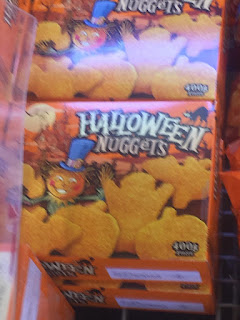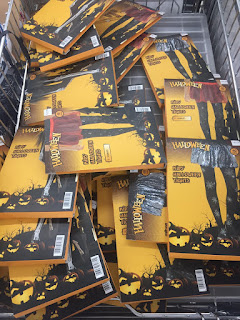Howdy. This is playwright Bryan Stubbles. Finally, my first blog entry from the interesting, yet relatively quiet town of Kokkola. I’ve spent my time exploring Kokkola, writing a lot, learning Finnish, making friends here and figuring out which supermarket is the cheapest.
Terve. Olen näytelmäkirjailija Bryan Stubbles. Viimeinkin, ensimmäinen blogikirjoitukseni mielenkiintoisesta, mutta suhteellisen hiljaisesta kaupungista, Kokkolasta. Olen kuluttanut aikaani tutkimalla Kokkolaa, kirjoittaen paljon, opiskellen suomea, ystävystyen ja ottaen selville mikä supermarketti on halvin.

I was told to write this blog whenever I felt like it. Last week gave me something odd enough to write about. Well, odder than everyone assuming I’m Swedish when I try to speak Finnish.
Minua pyydettiin kirjoittamaan blogia aina kun siltä tuntuu. Viime viikolla koin niin oudon tapahtuman, että siitä piti kirjoittaa. Kuitenkin oudompaa kuin se, että kaikki olettavat minun olevan ruotsalainen, kun yritän puhua suomea.
I was meeting a friend at Café Stiina - when I arrived, three women were chatting with the owner.
They wore costumes and make-up. My first thought was that the women were going to a Halloween party. Finland seems to have absorbed some superficial Halloween traits from the US.
Tapasin ystäväni Café Stiinassa – kun saavuin paikalle, kolme naista jutteli kahvilan omistajan kanssa.
Heillä oli puvut ja he olivat meikattuja. Ensimmäinen ajatukseni oli, että naiset ovat menossa Halloween-juhlaan. Suomalaiset ovat näköjään omaksuneet joitakin pinnallisia Halloween-piirteitä Yhdysvalloista.
I found the following in Kokkola:
Löysin seuraavia asioita Kokkolasta:
Nothing says "Halloween" more than Halloween-themed chicken nuggets.
Mikään ei ole niin "Halloween" niin kuin Halloween-teemaiset kananugetit.
Or Jack O'Lantern fries.
Tai kurpitsalyhdyn muotoiset pakasteperunat.
Kids' stockings?
Lasten sukkia?
Satanic Fanta, Kokkola-style.
Saatanallista Fantaa, Kokkolan malliin.
Halloween is my favorite holiday. I’ve even written plays about it. And blog posts on my own blog.
The women were speaking English with the owner, so I thought they might be foreigners. I told them their make-up and costumes looked really nice. They said they were doing a presentation at the local library about Day of the Dead. This is a Mexican holiday that lasts from October 31st to November 2nd and can be found in the US, as well.
Naiset puhuivat englantia omistajan kanssa, joten ajattelin että he ovat ehkä ulkomaalaisia. Kerroin heille, että heidän meikkauksensa ja asunsa olivat tosi hienoja. He kertoivat esiintyvänsä paikallisessa kirjastossa aiheesta kuolleiden päivä (Day of the Dead). Se on Meksikolainen juhla, joka kestää lokakuun 31:stä marraskuun 2:een ja sitä juhlitaan myös Yhdysvalloissa.
Day of the Dead (Dia De Los Muertos) is a two day holiday that reunites the living and dead. Families create ofrendas (Offerings) to honor their departed family members that have passed. These altars are decorated with bright yellow marigold flowers, photos of the departed, and the favorite foods and drinks of the one being honored. The offerings are believed to encourage visits from the land of the dead as the departed souls hear their prayers, smell their foods and join in the celebrations!
Kuolleiden päivä (Dia De Los Muertos) on kaksipäiväinen juhla, joka yhdistää uudelleen elävät ja kuolleet. Perheet tekevät uhrilahjoja (ofrendas) kunnioittamaan edesmenneitä perheenjäseniään. Alttarit koristellaan kirkkaan keltaisin kehäkukin, edesmenneiden valokuvin sekä muistettavien henkilöiden lempiruoin ja -juomin. Uhrilahjojen uskotaan rohkaisevan edesmenneitä vierailemaan kuolleiden maasta, koska he kuulevat rukoukset, haistavat ruokien tuoksut ja siten saavat heidät liittymään juhlintaan.
Don't ever call it "Mexican Halloween." Like. Ever. Though more and more, it is influencing Halloween.
The main woman I spoke with sported Catrina makeup.
Älä ikinä kutsu sitä "Meksikolaiseksi halloweeniksi". Koskaan, vaikka se yhä enemmässä määrin vaikuttaa Halloweeniin.
Keskeisellä hahmolla, jonka kanssa juttelin, oli Catrina-meikki.
Variations of the Catrina makeup done by, modeled by and photographed by the great Jennifer West.
Muunnelmia Catrina-meikistä. Kaikki Jennifer Westin tekemiä ja kuvaamia.
Catrina makeup is in imitation of a political cartoon from 1913. The point of the cartoon was that no matter how much well-to-do Mexicans copied European ways, death takes us all.
Catrina-meikki imitoi poliittista pilakuvaa vuodelta 1913. Pilakuvan idea oli, että vaikka varakkaat meksikolaiset kopioivatkin eurooppalaisia tapoja, kuolema kohtaa meidät kaikki.
I said “Día de los muertos” in Spanish. She seemed happy I knew the Spanish name of the holiday. Maybe I should've told her I knew the other name, too.
Sanoin hänelle “Día de los muertos”, espanjaksi. Hän oli tyytyväinen, että tunsin juhlan espanjankielisen nimen. Ehkä minun olisi pitänyt kertoa hänelle, että tunnen sen toisen nimenkin.
You can imagine Kokkola, Finland is one of the last places I’d expect to see anything Day of the Dead-ish.
Voit kuvitella, että Kokkola, Suomessa, olisi viimeisiä paikkoja, joissa odotin näkeväni jotakin Day of the Dead -juhlaan liittyvää.
They do have pretty badass cemeteries here.
Täällä on sairaan kovia hautausmaita.
I remember the café owner saying something about prefering to celebrate the living.
The second woman had the regular "sugar skull" makeup on.
Muistan kahvilanomistajan sanoneen, että hän suosii elävien juhlimista.
Toisella naisella oli tavallinen sokerikallo-meikki.
Sugar skulls. Sokerikalloja.
Sugar skull makeup, made and photographed by Jennifer West and modeled by Tennille Benally and Brian March.
Jennifer Westin tekemät ja kuvaamat sokerikallot. Malleina Tennille Benally ja Brian March.
Wait, what? "Halloween" masks at a shop here. Do we tell them?
Hetkinen, mitä? "Halloween" -naamareita paikallisessa kaupassa. Kerrotaanko heille?
The third woman had a very Halloweenized witch outfit on. I couldn’t tell where they were from, but they weren’t native English speakers. I wanted to ask if I could take their picture, but wussed out.
We all said goodbye. I threw in “Hasta luego” and the Catrina woman seemed surprised and answered back with that.
Kolmannella naisella oli Halloween-tyylinen noita-asuste. En saanut selville mistä he olivat, mutta englanti ei ollut heidän äidinkielensä. Ajattelin kysyä saanko ottaa heistä kuvan, mutten uskaltanut.
Sanoimme näkemiin. Heitin sekaan “Hasta luego” ja Catrina-nainen näytti yllättyneeltä ja vastasi samoin sanoin.
Later my American friend arrived. I told her about the Day of the Dead women. We decided to go to the library to see their presentation. (From our conversation, my understanding was they were headed to the presentation straightaway) We looked all around the library. Saw nothing. Asked the workers there. They hadn't heard anything about it. Women walking around dressed up for Day of the Dead would kinda stand out in Kokkola's library.
Myöhemmin, amerikkalainen ystäväni tuli paikalle. Kerroin hänelle kuolleiden päivä -naisista. Päätimme mennä kirjastoon katsomaan heidän esitystään. (Keskustelumme pohjalta, ymmärsin, että he menvät esiintymään saman tien.) Etsimme koko kirjastosta, muttemme nähneet mitään. Kysyin kirjaston työntekijöiltä. He eivät olleet kuulleet asiasta mitään. Luulisi naisten, jotka ovat pukeutuneet kuolleiden päivän asusteisiin, erottautuvan Kokkolan kirjastossa.
My friend and I returned to the coffee shop. The owner confirmed that they had indeed said they were off to the library. The owner wasn’t sure where they were from, but thought at least one was Swedish.
Maybe I misunderstood something. I don’t think they would play a “trick” - BTW the Halloween refrain “trick or treat?” refers to the older Halloween custom of playing tricks on people during Halloween, especially if they were miserly and didn’t give you any treats.
Palasimme kahvilaan. Kahvilanomistaja vahvisti, että naiset olivat puhuneet menevänsä kirjastoon. Omistaja ei tiennyt mistä naiset olilvat kotoisin, mutta luuli, että ainakin yksi oli ruotsalainen.
Ehkä käsitin jotakin väärin. En usko heidän keppostelleen kanssani. Muuten, halloweeniin liittyvä hokema "karkki vai kepponen?" (trick or treat?) viittaa vanhempaan perinteeseen, jossa Halloweenin aikaan tehtiin kepposia ihmisille, etenkin, jos he olivat pihejä eivätkä antaneet karkkeja.
Maybe they did play a trick on me and simply didn’t want some American guy bugging them.
My mind went over the possibilities of some foreign ladies celebrating Day of the Dead in Kokkola who ominously...disappear into the night. I've already started writing the play.
Ehkä he tekivät minulle kepposen eivätkä vain halunneet jonkun amerikkalaisen häiritsevän heitä.
Aloin mielessäni kuvitella ulkomaalaisia naisia viettämässä kuolleiden päivää Kokkolassa, jotka pahaenteisesti … katoavat yöhön. Olen jo aloittanut näytelmän kirjoittamisen.









































